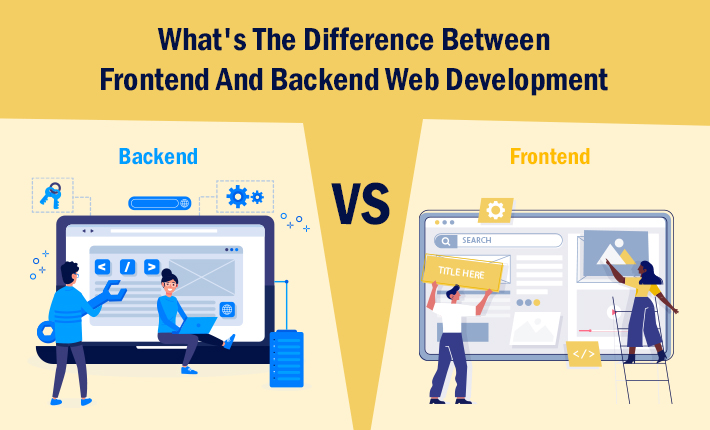Web development involves a combination of frontend and backend development, each serving distinct roles in creating functional and visually appealing websites. In this blog post, we will delve into the difference between frontend and backend web development. We will explore their unique responsibilities, the technologies involved, and how they work together to deliver seamless user experiences. By understanding the distinctions between frontend and backend development, you can gain a comprehensive understanding of the web development process and make informed decisions when building your own websites or collaborating with development teams.
I. Frontend Web Development: Frontend web development focuses on the client-side of web applications—the part that users interact with directly. It involves creating the visual and interactive elements that users see and engage with in their web browsers. Here are some key aspects of frontend development:
1. HTML: Hypertext Markup Language (HTML) provides the structure and content of web pages. It defines the elements and layout of the webpage, such as headings, paragraphs, images, links, and forms.
2. CSS: Cascading Style Sheets (CSS) determines the presentation and styling of HTML elements. It controls the layout, colors, fonts, and other visual aspects of the webpage, ensuring a visually appealing and consistent user interface.
3. JavaScript: JavaScript is a programming language that adds interactivity and dynamic functionality to web pages. It enables developers to create interactive elements, handle user input, manipulate data, and make requests to backend servers.
4. Frontend Frameworks: Frontend frameworks like React, Angular, and Vue.js provide a structured approach to building complex web applications. They offer pre-built components, state management, and routing systems to enhance productivity and maintainability.
II. Backend Web Development: Backend web development focuses on the server-side of web applications—the behind-the-scenes operations that power the frontend. It involves handling data storage, processing user requests, and delivering dynamic content. Here are some key aspects of backend development:
1. Server-Side Languages: Backend development requires using programming languages like Python, PHP, Ruby, or Node.js to write server-side code. These languages enable developers to handle data operations, communicate with databases, and perform business logic.
2. Databases: Backend development involves interacting with databases to store and retrieve data. It requires knowledge of database management systems like MySQL, PostgreSQL, MongoDB, or Redis. Backend developers use SQL or NoSQL queries to manage data effectively.
3. Server-Side Frameworks: Backend frameworks provide tools and libraries to streamline development and handle common backend tasks. Examples include Django (Python), Laravel (PHP), Ruby on Rails (Ruby), and Express.js (Node.js).
4. APIs: Application Programming Interfaces (APIs) enable communication between different software systems. Backend developers design and develop APIs to expose certain functionalities of their applications, allowing other systems or frontend clients to access and interact with data.
III. Collaboration and Interaction: Frontend and backend development are interdependent and require seamless collaboration to create cohesive web applications. Here are some aspects of their collaboration:
1. Communication: Frontend developers and backend developers need to effectively communicate to align on project requirements, data structures, and functionality. Clear communication ensures a smooth integration of frontend and backend components.
2. API Integration: Frontend developers consume APIs provided by backend developers to fetch and manipulate data dynamically. This collaboration allows frontend developers to display real-time information to users and enables interactive features.
3. User Experience: The collaboration between frontend and backend development plays a crucial role in delivering a seamless user experience. Frontend developers focus on creating intuitive interfaces, while backend developers ensure efficient data retrieval and processing, resulting in fast and responsive websites.
4. Testing and Debugging: Collaboration is essential during the testing and debugging phases of web development. Frontend and backend developers work together to identify and resolve issues that may arise in the functionality or performance of the web application. Effective collaboration in testing ensures a smooth user experience across different browsers and devices.
IV. Key Differences and Overlaps: While frontend and backend development have distinct focuses, there are areas where their responsibilities overlap. Here are some key differences and overlaps between frontend and backend development:
1. User Interface vs. Server-Side Logic: Frontend developers primarily focus on creating visually appealing user interfaces and optimizing the user experience, while backend developers handle server-side logic, database interactions, and data processing.
2. Technologies and Tools: Frontend developers work with HTML, CSS, and JavaScript, along with frontend frameworks and libraries. Backend developers use server-side languages, databases, and backend frameworks. However, both frontend and backend developers may use tools for version control, package management, and testing.
3. Data Management: Backend developers are responsible for handling data storage, retrieval, and manipulation, while frontend developers primarily focus on displaying and interacting with that data. Both frontend and backend developers should have a good understanding of data structures and data management principles.
4. Collaboration and Communication: Effective collaboration and communication are crucial for successful web development projects. Frontend and backend developers need to align their work and ensure seamless integration of frontend and backend components.
V. Full Stack Development: Full stack development combines both frontend and backend development skills. Full stack developers have a solid understanding of frontend technologies, server-side languages, and databases. They can handle all aspects of web development, from designing user interfaces to implementing server-side logic and database management. Full stack developers can work independently on smaller projects or take up roles that require a broad range of skills.
Conclusion:
Frontend and backend development are essential components of web development, each with its unique roles and responsibilities. Frontend developers focus on creating user interfaces and ensuring an intuitive user experience, while backend developers handle server-side operations and data management. Collaboration and communication between frontend and backend developers are crucial for seamless integration and optimal performance of web applications. Understanding the difference between frontend and backend development allows web developers to specialize in their area of interest or pursue full stack development. By leveraging the strengths of both frontend and backend development, web developers can create robust and engaging websites that meet user needs and deliver exceptional experiences.





Leave a reply